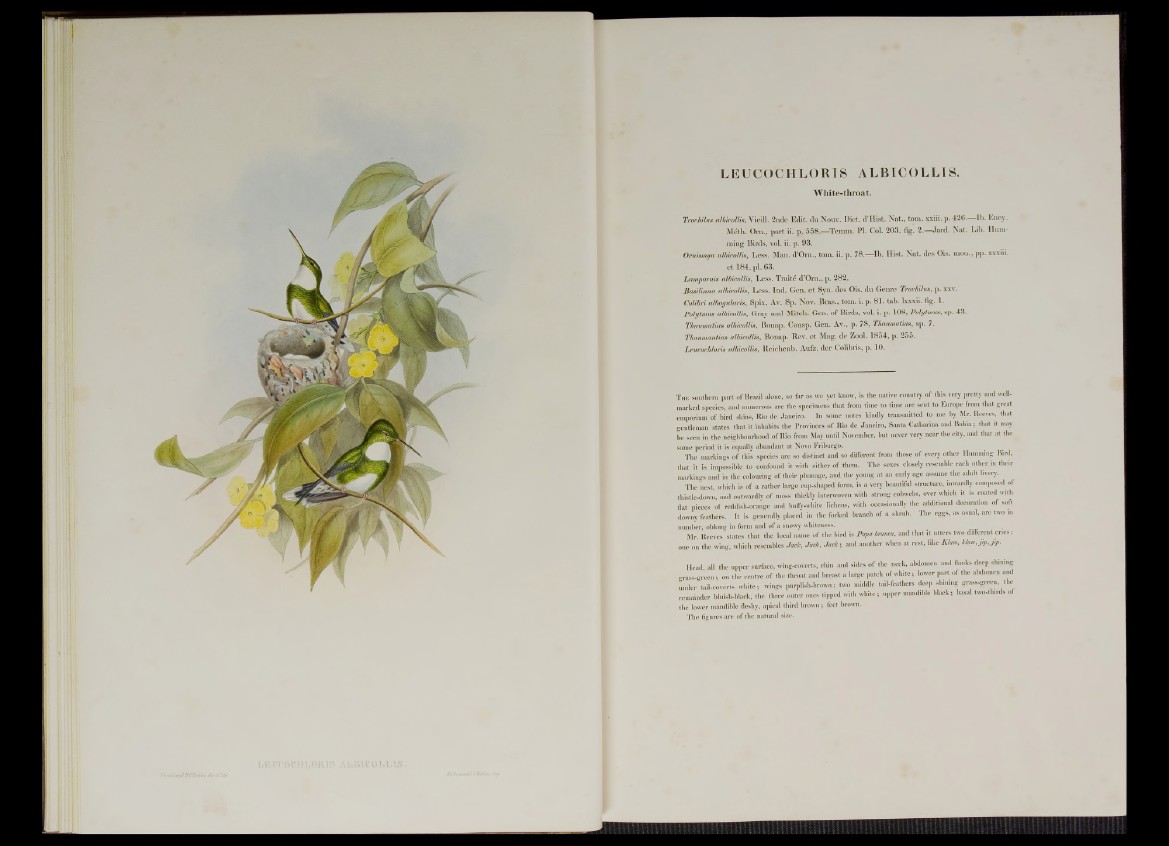
LEUCOCHLORIS ALBICOLLIS.
White-throat.
Trochilus albicottis, Vieill. 2nde Edit, du Nouv. Diet. d’Hist. Nat., tom. xxiii. p. 426.— lb . Ency.
Méth. Om., part ii. p. 558.—Temm. PI. Col. 203. fig. 2.—Jard. Nat. Lib. Humming
Birds, vol. ii. p. 93.
Ornismya albicottis, Less. Man. d’Orn., tom. ii. p. 78.— lb . Hist. Nat. des Ois. mou., pp. xxxiii.
e t 184. pl. 63.
Lampornis albicottis, Less. Traité d’Om., p. 282.
Basilinna. albicottis, Less. Ind. Gen. e t Syn. des Ois. du Genre Trochilus, p. xxv.
Colibri albogularis, Spix, Av. Sp. Nov. Bras., tom. i. p. 81. tab. lxxxii. fig. 1.
Pohjtmus albicottis, Gray and Mitch. Gen. of Birds, vol. i. p. 108, Pohjtmus, sp. 43.
Thaumatias albicottis, Bonap. Consp. Gen. Av., p. 78, Thaumatias, sp. 7.
Thaumantias albicottis, Bonap. Rev. e t Mag. de Zool. 1854, p. 255.
Leucochloris albicottis, Reichenb. Aufz. der Colibris, p. 10.
T he southern part of Brazil alone, so far as we yet know, is the native country of this very pretty and well-
marked species, and numerous are the specimens that from time to time are sent to Europe from that great
emporium of bird skins, Rio de Janeiro. In some notes kindly transmitted to me by Mr. Reeves, that
gentleman states that it inhabits the Provinces of Rio de Janeiro, Santa Catharina and Bahia; that it may
be seen in the neighbourhood of Rio from May until November, but never very near the city, and that at the
same period it is equally abundant at Novo Friburgo.
The markings of this species are so distinct and so different from those of every other Humming Bird,
that it is impossible to confound it with either of them. The sexes closely resemble each other in their
markings and in the colouring of their plumage, and the young at an early age assume the adult livery.
The nest, which is of a rather large cup-shaped form, is a very beautiful structure, inwardly composed of
thistle-down, and outwardly of moss thickly interwoven with strong cobwebs, over which it is coated with
flat pieces of reddish-orange and bufly-white lichens, with occasionally the additional decoration of soft
downy feathers. It is generally placed in the forked branch of a shrub. ' The eggs, as usual, are two m
number, oblong in form and of a snowy whiteness.
Mr Reeves states that the local name of the bird is Papa branca, and that it utters two different cries:
one on the wing, which resembles Jack, Jack, Jack-, and another when at rest, like Klan, klaw,jip,jV.
Head all the upper surface, wing-coverts, chin and sides of the neck, abdomen and flanks deep shining
grass-green • on the centre of the throat and hreast a large patch of white; lower part of the abdomen and
under tail-coverts white; wings purplish-brown; two middle tail-feathers deep shining grass-green the
remainder bluish-hlack, the three outer ones tipped with white; upper mandible black; basal two-thirds of
the lower mandible fleshy, apical third brown; feet brown.
The figures are of the natural size.